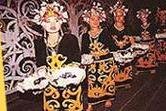Dayaks are generally categorised as part of a wider Austronesian-speaking group, local to the island of Borneo in the Malay Archipelago. There are about 8 million Dayaks in Borneo.
Sarawak - Dayak Main Group
In general the Dayak Community can be divided into three main groups, the Iban, the Bidayuh and the Orang Ulus. The Dayak indigeneous religion is a form of animism — worshiping of multiple gods like the rice goddess — then known as Kaharingan. Over time, some customs died and some lived on until it took its current shape which is closer to Buddhism and Hinduism. Since the last 50 years, many Dayaks have converted to either Islam or Christianity.
Headhunting
Headhunting is a gruesome tradition that is no longer practiced in Dayak culture (at least not that we know of). In the days of the Brooke Dynasty in Sarawak, victorious Dayak warriors would parade the heads of enemies as trophies. The government subsequently put a stop to the practice and now all that remains is the skulls on parade in some homes.
Longhouse
The traditional Dayak Longhouse can hold up to 200 families and measure up to 100 yards long. Whole communities can live in family apartments units next door to each other in one single bamboo block which is built on stilts. Today, Dayaks live in modern longhouse which mostly equipped with modern infrastructure facilities.
Music & Dance
The most common form of musical instrument is the guitar-like ‘sape’, a heritage of the Orang Ulus. It is made of wood and between three to five wires typically used for fishing. A person who plays the sape is usually accompanied by a dance, typically the Ngajat Iban, a traditional warrior dance for men, and the Datun Julud, a hornbill dance for women.


No comments:
Post a Comment